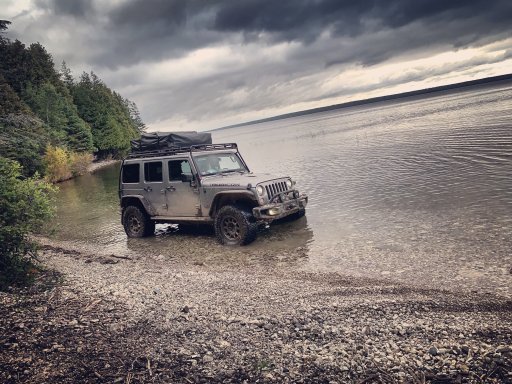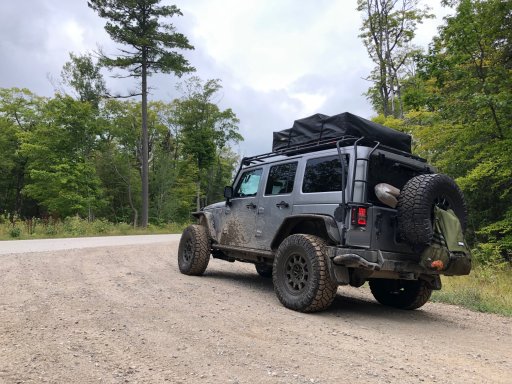I have a 17" JKUR Hard Rock, the vehicle came equipped with AEV 2.5" lift, on 35"s with AEV geometry correction brackets.
I got the jeep in February, since I have outfitted the the rig to make it more trail ready. I've added a front winch with steel line,gobi roof rack with a smittybuilt RTT, AEV rear bumper with a tire carrier ( I also put water in it), metal flat fenders and aluminium fender liners, high lift jack and etc.
I packed the rig up with recovery gear, tools, cooler and etc and headed out to Drummond Island over the Labor Day weekend.


Jeep performed beautifully. However, loaded up with all the accessories, gear, food and water I am definitely over the AEV recommended 250 lbs above stock weight limit, and I could feel it driving the jeep.
I am perfectly happy with the lift height and the over all capability of the jeep.
What would be some options to increase the load capacity aside from going to another lift? I started doing some research and I came across Old Man Emu 2620 2.25" Lift Rear Heavy Load (660lbs) Coil Spring. What are your thoughts on adding those springs to my existing set up? Has anyone run this combo?
I should mention that 99% of the time the jeep serves as a daily, I keep the rack on while I remove the tent and other stuff. I am looking into building a rear drawer which will add weight back in.
Feedback is greatly appreciated.
I got the jeep in February, since I have outfitted the the rig to make it more trail ready. I've added a front winch with steel line,gobi roof rack with a smittybuilt RTT, AEV rear bumper with a tire carrier ( I also put water in it), metal flat fenders and aluminium fender liners, high lift jack and etc.
I packed the rig up with recovery gear, tools, cooler and etc and headed out to Drummond Island over the Labor Day weekend.


Jeep performed beautifully. However, loaded up with all the accessories, gear, food and water I am definitely over the AEV recommended 250 lbs above stock weight limit, and I could feel it driving the jeep.
I am perfectly happy with the lift height and the over all capability of the jeep.
What would be some options to increase the load capacity aside from going to another lift? I started doing some research and I came across Old Man Emu 2620 2.25" Lift Rear Heavy Load (660lbs) Coil Spring. What are your thoughts on adding those springs to my existing set up? Has anyone run this combo?
I should mention that 99% of the time the jeep serves as a daily, I keep the rack on while I remove the tent and other stuff. I am looking into building a rear drawer which will add weight back in.
Feedback is greatly appreciated.








